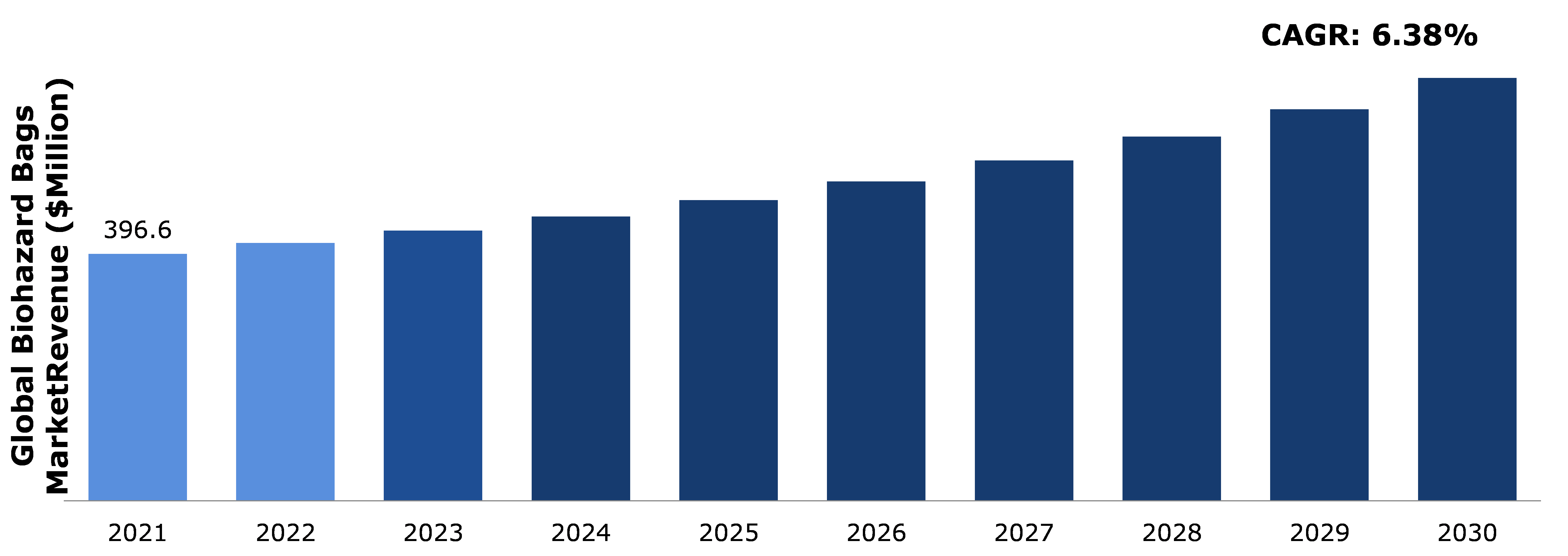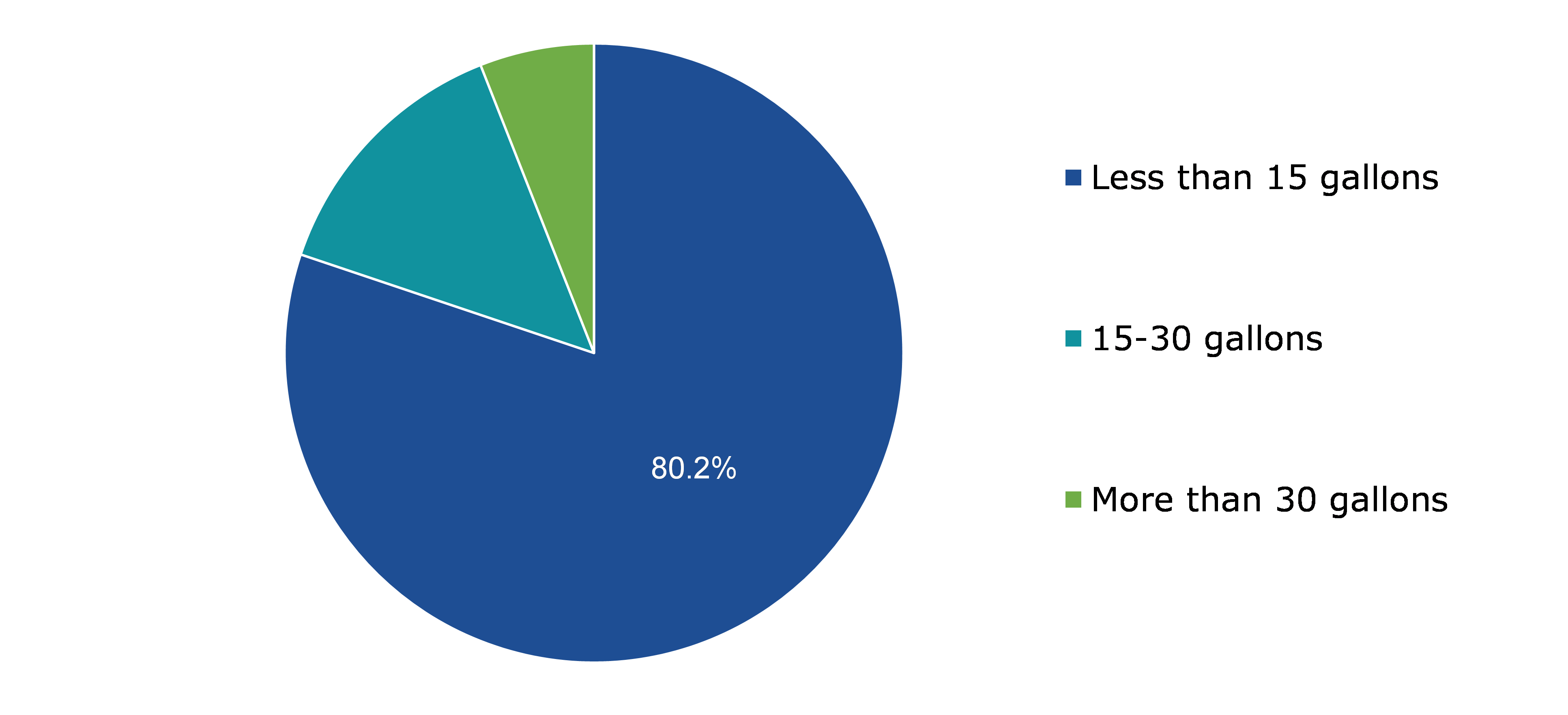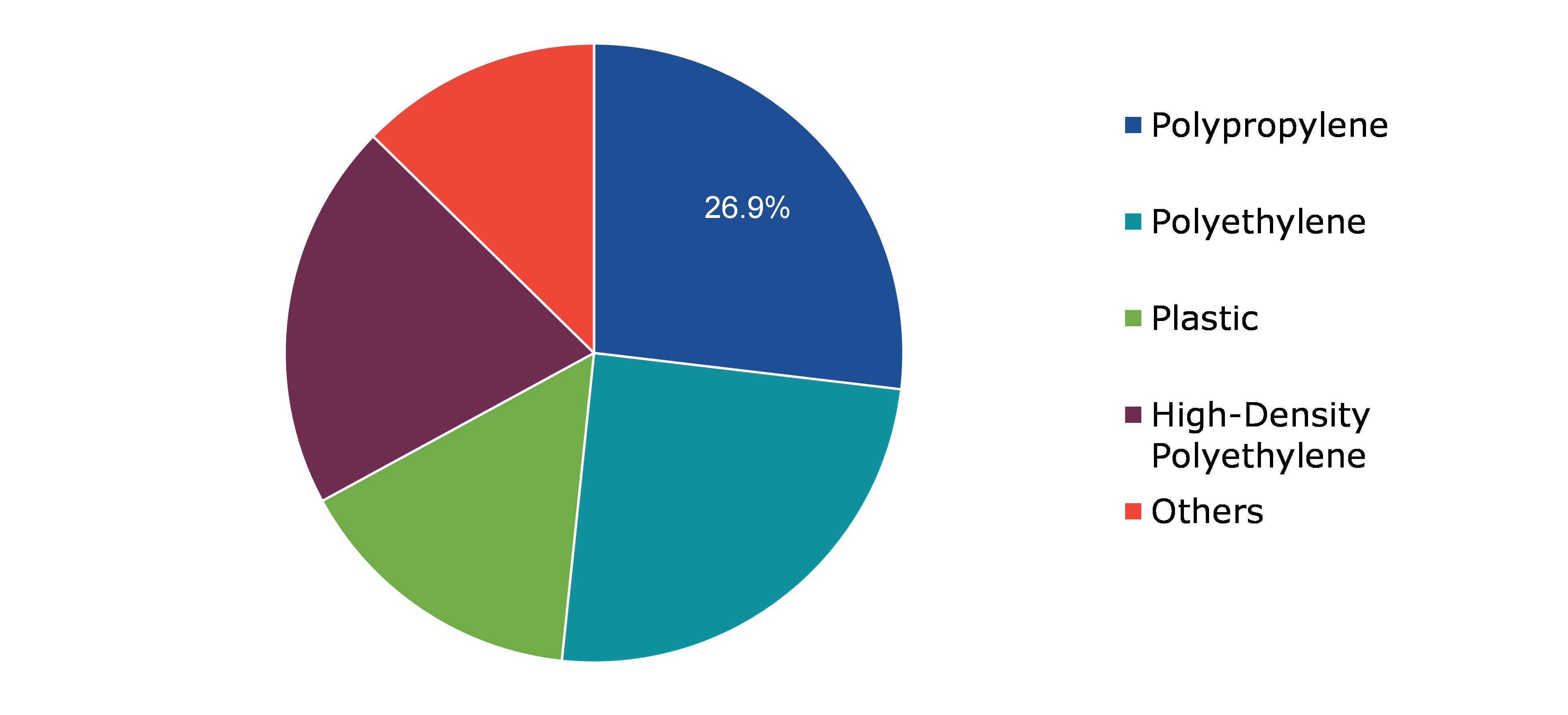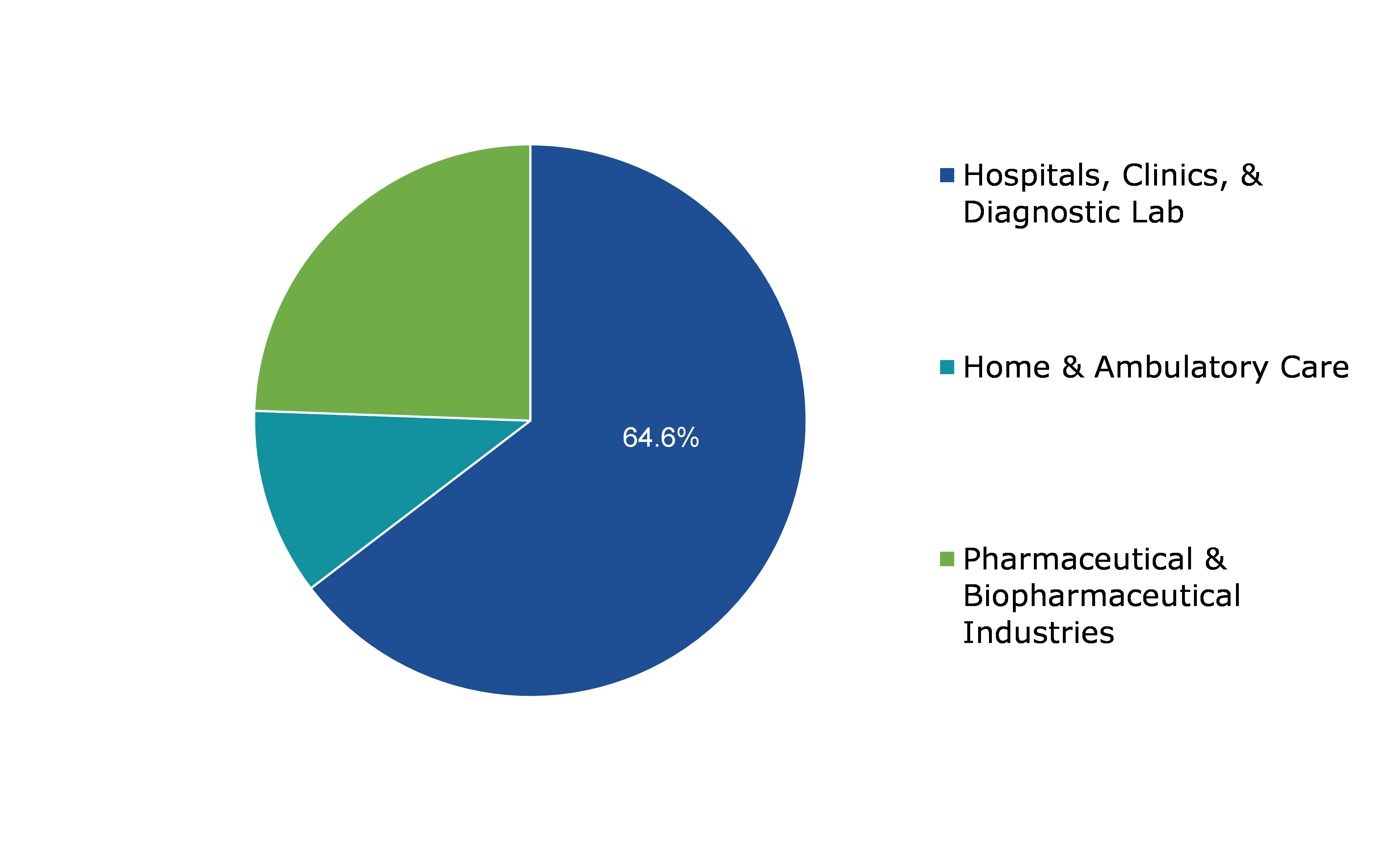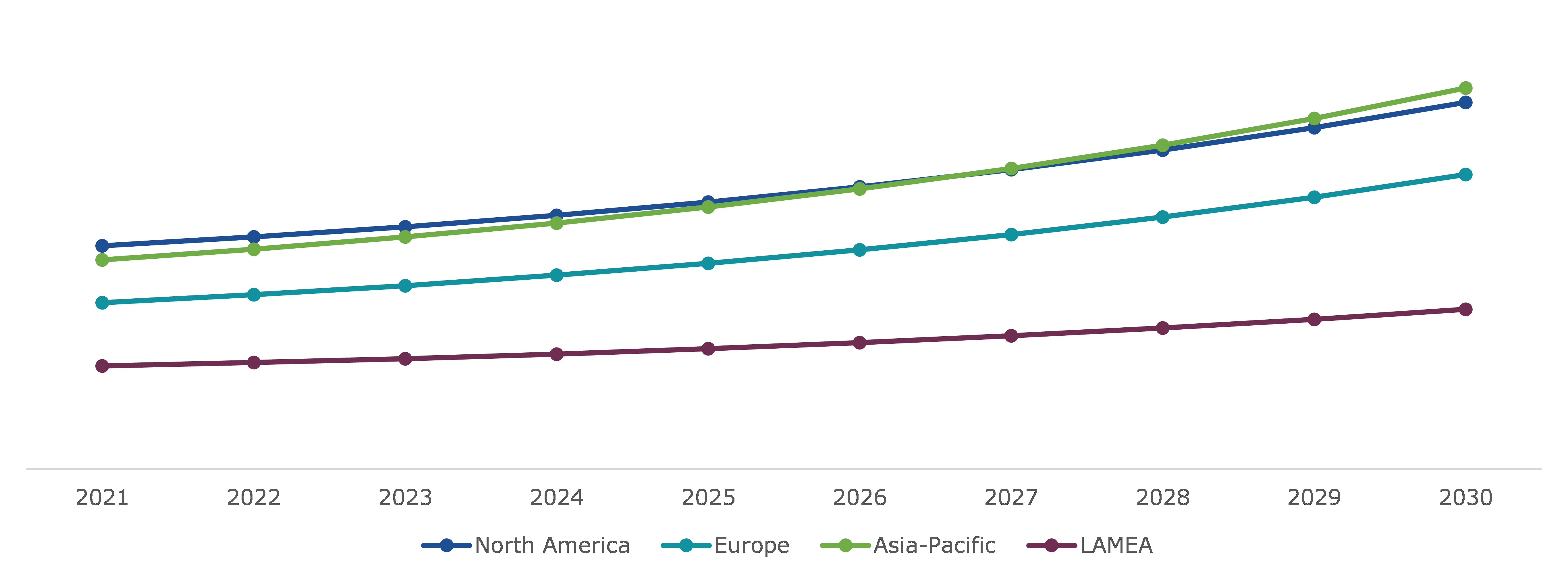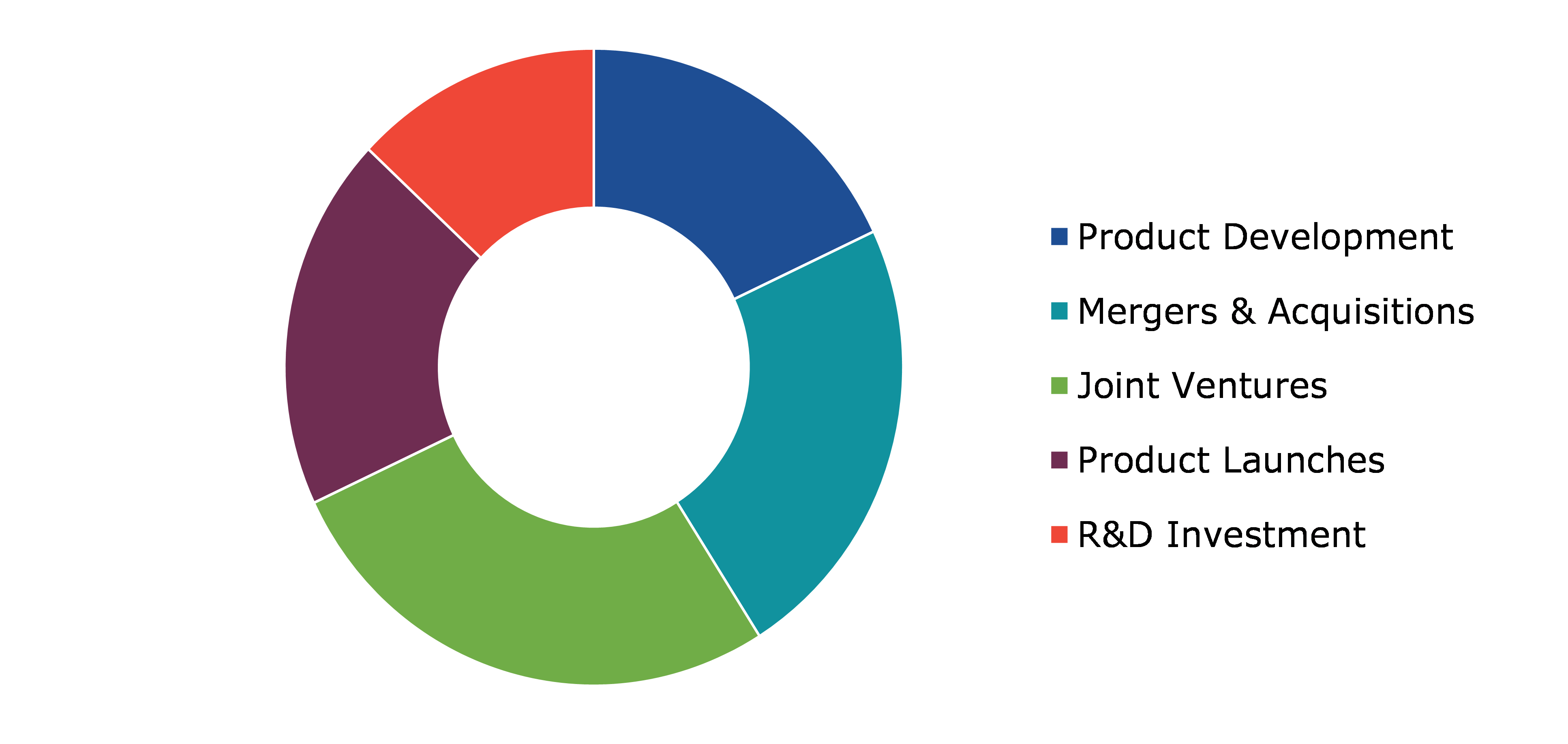Biohazard Bags Market Report
RA00414
Biohazard Bags Market by Capacity Type (Less than 15 Gallon, 15 to 35 Gallon, and More than 35 Gallon), Material Type (Polypropylene, Polyethylene, Plastic, High-density Polyethylene, and Others), End-use (Hospitals, Clinics & Diagnostic Labs, Home & Ambulatory Care, And Pharmaceutical & Biopharmaceutical Industries), and Regional Analysis (Europe, North America, Asia-Pacific, and LAMEA): Global Opportunity Analysis and Industry Forecast, 2022-2030.
Global Biohazard Bags Market Analysis
The global biohazard bags market size was $396.6 million in 2021 and is predicted to grow with a CAGR of 6.38%, by generating a revenue of $679.1 million by 2030.
Biohazard Bags Market Synopsis
As the need for cleanliness and sanitation in the medical sector is rising every day, the market for biohazard bags is becoming more popular. Biohazard bags are recyclable and disposable bags. These bags are available in four different colors for different types of waste which include yellow, blue, black, and red. These bags are used for discarding of infectious waste and the treatment of items such as wound bandages, cotton, used swab collection kits, and others that have been contaminated by infectious waste. Medical waste is collected in these bags for disposal and waste management. Serious health problems may occur due to improper management of the biohazard waste collected in these bags, which may eventually lead to an increase in number of patients in the hospital, drug development research, clinical disease testing, and the pharmaceutical industry. Due to this issue, there will be requirement for proper garbage disposal methods and containers. In order to prevent punctures from sharp things, biohazard waste bags are typically made using materials such as High Density Polyethylene (HPDE). Low Density Polyethylene (LDPE) has a high impact strength and exceptional chemical resistance. These factors are expected to increase the demand for the biohazard bags in the market.
However, some factors such as improper waste management of these biohazard bags can cause health problems and at times this mismanagement of waste can cause chronic diseases such as HIV, tuberculosis, cancer, and even chemical burns.
Due to the healthcare industry’s rapid expansion and increased need for sanitation due to COVID-19, requirement for waste disposal systems is ultimately rising, which is driving a significant global increase in the biohazard bags market growth. These bags are made with durable plastic and these bags are recyclable as well. Low-density polyethylene bags with sterilizing storage are typically used to hold all types of solid and liquid waste. High temperature bags, light-sensitive sample holding bags, and sealable flip bags are varieties available. In the upcoming years, these variables may offer attractive chances for the global biohazard bags market.
According to regional analysis, the North America biohazard bags market size accounted for $126.1 million in 2021 and is predicted to grow with a CAGR of 5.89% in the projected timeframe.
Biohazard Bags Overview
Biohazard bags are sustainable bags made from strong plastic. Hazardous medical wastes, such as blood products, chemical substances, toxic substances, as well as hazardous compounds among others, are collected and disposed by using biohazard bags. These bags are widely used in hospitals, clinical laboratories as well as research centers to dispose and carry the waste produced in these facilities to the waste management centers and incineration centers.
COVID-19 Impact on the Global Biohazard Bags Market
The COVID-19 pandemic's spread has resulted in an increase in demand for biohazard bags due to requirement to preserve hygiene and cleanliness. Ministry of Environment, Forest and Climate Change, India, revised and amended guidelines for biomedical waste management in 2019, by adding and restructuring new rules. Number of governmental and non-governmental organizations, as well as healthcare institutions such as hospitals, clinics, and medical labs, are making considerable efforts to stop the coronavirus from spreading. Increased death rate during the pandemic increased biohazard waste produced at funeral homes as well as autopsy centers, which resulted in increased demand for the biohazard bags for the disposal. As a result, there is a rising need for biohazard bags in the forecast period, which will boost expansion of the global biohazard bags market.
Moreover, there has been an increase in number of safety rules and standards imposed by governments of various countries during the pandemic to avoid spread of COVID-19. Rules such as compulsion on wearing of mask, use of PPE kits, rapid tests or COVID test before traveling were imposed. This lead to increase in the volume of biohazard waste cross the world. Doctors were working throughout the pandemic and were provided with safety kits. These safety kits contained masks, PPE kits, face shield, gloves, caps, and others. These safety gears were onetime use and meant to be disposed after use, resulting in increasing demand for biohazard bags in near future.
Increased Volume of Medical Waste & Need for Proper Disposal of Hazardous Waste as well as Medical Waste are Likely to Generate Astonishing Revenue for the Global Biohazard Bags Market
In one year from June 2020 – June 2021, India generated 56,898 tons of COVID-19 bio medical waste as per the data released by the Ministry of Environment, Forest and Climate Change. In U.S., more than five million tons of medical waste is produced every year. This waste is produced by hospitals, pathological laboratories, nursing homes, clinics, as well as healthcare facilities and it is important to dispose and manage properly. In the process of disposal of medical waste, biohazard bags play important role to collect, carry, and dispose them. These bags can contain sharp objects used for medical purpose such as needles, scissors, glass bottles, ampules, injections, cotton, wound care bandages, blood, surgical waste, and used safety gears such as masks, gloves, PPE kits, and others. Such waste is produced daily and the volume of this waste production is increasing daily which is resulting in increased requirement of biohazard bags. These factors are expected to boost the global biohazard bags market size in near future.
Lack of Knowledge about Biohazard Bags and Awareness Regarding Proper Dispose Process may Restrain Growth of the Global Biohazard Bags Market
In countries such as Sri Lanka, Madagascar, Niger, Pakistan, Cambodia, and others awareness regarding use of biohazard bags and their disposal is less. Improper biohazard waste management in these countries can cause serious health issues and chronic diseases as well as can contaminate the environment. These are one of the major restricting factors for revenue growth of the biohazard bags market.
Expanding Healthcare Sector in Various Countries may Open up Opportunities in the Global Biohazard Bags Market
Countries such as India, Brazil, Myanmar, Thailand, Turkey, and others are focusing more on the healthcare sector as it is one of the most important sectors which contributes for the development of nation. In Indian budget 2022, budget of more than $10 billion (86,200 crores) was allocated to the healthcare sector. The COVID-19 pandemic was eye opener calamity for development of healthcare system around the world. Developing healthcare industry around the globe is resulting in increasing volume of the waste produced by these organizations. For the proper management of biomedical waste produced by these organizations, biohazard bags play important role. All the medical and hazardous waste produced can be disposed with the help of biohazard bags and these factors are likely to create growth opportunities for major players in the global biohazard bags market.
Global Biohazard Bags Market, by Capacity Type
Based on capacity type, biohazard bags market share is further divided into less than 15 gallon, 15 to 35 gallon, and more than 35 gallon. Among these, less than 15 gallon sub-segment is expected to be fastest growing and dominating during the forecast period.
Global Biohazard bags Market Share, by Capacity Type, 2021
Source: Research Dive Analysis
The less than 15 gallon sub-segment is expected to be fastest growing and generate a revenue of $552.7 million by 2030, growing from $317.9 million in 2021. Less than 15 gallon biohazard bags are mostly used in hospitals, pathological laboratories, medical facilities, and nursing homes. These bags can be used for the effective collection of infectious agents from labs, waste from ill patients, used testing kits, swabs, used bandages, and others.
These bags are made with thick plastic to avoid the leakages and spills. These bags are tough and cannot be easily tore. Less than 15 gallon biohazard bags are printed with the world wide recognized biohazard symbols. Increased use of safety gears and necessity for the rapid test for COVID-19 as well as increasing production medical waste are factors expected to drive the market growth in analysis period.
Global Biohazard Bags Market, by Material Type
Based on material type, the global biohazard bags market has been divided into polypropylene, polyethylene, plastic, high-density polyethylene, and others. Among these, polypropylene sub-segment expected to account for highest revenue share whereas polyethylene is expected to be the fastest growing during the forecast period.
Global Biohazard Bags Market Share, by Material Type, 2021
Source: Research Dive Analysis
The polypropylene sub-segment is expected to have highest market share during forecast period and generate a revenue of $175 million by 2030, growing from $106.6 million in 2021. Polypropylene is widely used plastic polymer for biohazard bags manufacturing as it offers excellent chemical impact resistance properties as well as it is leakage proof and can be heat sealed. Polypropylene is lightweight, durable, flexible, and recyclable material which makes these polymers perfect material for the biohazard bags. These factors are expected to majorly attribute to growth of the sub-segment.
The polyethylene sub-segment is expected to be fastest growing during forecast period and may generate a revenue of $176.6 million by 2030, growing from $98.3 million in 2021. Lightweight, functional synthetic polymer created from the polymerization of ethylene is called polyethylene (PE). Polyethylene (PE) ensures that the content is well-preserved because it is strong and resistant to outside effects. Polyethylene is incredibly flexible and adaptable. For a more personalized alternative, it also provides numerous thicknesses, clarities, and designer colors in addition to the protection. These factors are expected to majorly attribute to growth of the sub-segment.
Global Biohazard Bags Market, by End-use
Based on end-use, the global biohazard bags market is further divided into hospitals, clinics & diagnostic labs, home & ambulatory care, and pharmaceutical & biopharmaceutical industries. Among these, hospitals, clinics & diagnostic labs sub-segment is expected to account for highest revenue share during the forecast period.
Global Biohazard bags Market Share, by End-Use 2021
Source: Research Dive Analysis
The hospitals, clinics, & diagnostic lab sub-segment is expected to have highest market share and generate a revenue of $256.3 million by 2030, growing from $442.8 million in 2021.As per data from Word Health Organization (WHO), more than eight billion doses of vaccine have been administered worldwide which produced 144,000 tons of waste in the form of needles and syringes between March 2020 and November 2021. During the same time period, it is estimated that approximately 87,000 tons of waste from Personal Protective Equipment (PPE) was generated. Most of these types of waste are generated in hospitals. These factors are expected to increase demand for biohazard bags, which may result in the increased market share during analysis period.
Global Biohazard Bags Market, by Region
The global biohazard bags market was investigated across Europe, North America, Asia-Pacific, and LAMEA.
Global Biohazard Bags Market Size and Forecast, by Region, 2021-2030 (USD Million)
Source: Research Dive Analysis
The Biohazard Bags Market in North America Region to be Dominant
The biohazard bags market size in North America accounted $126.1 million in 2021 and it is projected grow with a CAGR of 5.89%. The market for biohazard bags in North America has experienced significant expansion, mostly due to important factors such need for properly disposing of medical waste and significant investments made by market participants. Increasing ageing population and growing patient population in these regions are few of all reasons that are predicted to fuel the biohazard bags market expansion in the North America region.
Global Biohazard Bags Market Competitive Scenario
Product advancements, mergers, and acquisition are the common strategies followed by major market players. For instance, in February 2021, Justrite Safety Group, a global leader of safety product, launched a line of polywaste container bags that are designed to efficiently identify biohazard and infectious waste for the appropriate disposal and waste management.
Source: Research Dive Analysis
Leading companies in biohazard bags market are Transcendia, Daniels Health, BioMedical Waste Solutions, LLC., International Plastics Inc., SP Bel-Art, Thermo Fisher Scientific, MiniGrip, Abdos Labtech Private Limited, VEOLIA, and Stericycle.
| Aspect | Particulars |
| Historical Market Estimations | 2020-2021 |
| Base Year for Market Estimation | 2021 |
| Forecast Timeline for Market Projection | 2022-2030 |
| Geographical Scope | Europe, North America, Asia-Pacific, LAMEA |
| Segmentation by Capacity Type |
|
| Segmentation by Material Type |
|
| Segmentation by End-use |
|
| Key Companies Profiled |
|
Q1. What is the size of the biohazard bags market?
A. The global biohazard bags market size was over $ 396.6 million in 2021 and is further anticipated to reach $679.1 million by 2030.
Q2. Which are the leading companies in the biohazard bags market?
A. Transcendia, Daniels Health, BioMedical Waste Solutions, LLC, and International Plastics Inc. are some of the key players in the global biohazard bags market.
Q3. Which region possesses greater investment opportunities in the coming future?
A. North America possesses great investment opportunities for the investors to witness the most promising growth in the coming years.
Q4. What is the growth rate of the Asia-Pacific market?
A. The Asia-Pacific biohazard bags market is anticipated to grow at 7.11% CAGR during the forecast period.
Q5. What are the strategies opted by the leading players in this market?
A. Product advancement and mergers & acquisitions are the key strategies opted by the operating companies in this market.
Q6. Which companies are investing more on R&D practices?
A. International Plastics Inc. and VEOLIA are investing more on R&D activities for developing new products and technologies.
1.Research Methodology
1.1.Desk Research
1.2.Real time insights and validation
1.3.Forecast model
1.4.Assumptions and forecast parameters
1.5.Market size estimation
1.5.1.Top-down approach
1.5.2.Bottom-up approach
2.Report Scope
2.1.Market definition
2.2.Key objectives of the study
2.3.Report overview
2.4.Market segmentation
2.5.Overview of the impact of COVID-19 on Global Biohazard Bags Market
3.Executive Summary
4.Market Overview
4.1.Introduction
4.2.Growth impact forces
4.2.1.Drivers
4.2.2.Restraints
4.2.3.Opportunities
4.3.Market value chain analysis
4.3.1.List of raw material suppliers
4.3.2.List of manufacturers
4.3.3.List of distributors
4.4.Innovation & sustainability matrices
4.4.1.Technology matrix
4.4.2.Regulatory matrix
4.5.Porter’s five forces analysis
4.5.1.Bargaining power of suppliers
4.5.2.Bargaining power of consumers
4.5.3.Threat of substitutes
4.5.4.Threat of new entrants
4.5.5.Competitive rivalry intensity
4.6.PESTLE analysis
4.6.1.Political
4.6.2.Economical
4.6.3.Social
4.6.4.Technological
4.6.5.Environmental
4.7.Impact of COVID-19 on Biohazard Bags Market
4.7.1.Pre-covid market scenario
4.7.2.Post-covid market scenario
5.Biohazard Bags Market Analysis, by Capacity Type
5.1.Overview
5.2.Less than 15 Gallon
5.2.1.Definition, key trends, growth factors, and opportunities
5.2.2.Market size analysis, by region,2021-2030
5.2.3.Market share analysis, by country,2021-2030
5.3.15 to 35 Gallon
5.3.1.Definition, key trends, growth factors, and opportunities
5.3.2.Market size analysis, by region,2021-2030
5.3.3.Market share analysis, by country,2021-2030
5.4.More than 35 Gallon
5.4.1.Definition, key trends, growth factors, and opportunities
5.4.2.Market size analysis, by region,2021-2030
5.4.3.Market share analysis, by country,2021-2030
5.5.Research Dive Exclusive Insights
5.5.1.Market attractiveness
5.5.2.Competition heatmap
6.Biohazard Bags Market Analysis, by Material Type
6.1.Overview
6.2.Polypropylene
6.2.1.Definition, key trends, growth factors, and opportunities
6.2.2.Market size analysis, by region,2021-2030
6.2.3.Market share analysis, by country,2021-2030
6.3.Polyethylene
6.3.1.Definition, key trends, growth factors, and opportunities
6.3.2.Market size analysis, by region,2021-2030
6.3.3.Market share analysis, by country,2021-2030
6.4.Plastic
6.4.1.Definition, key trends, growth factors, and opportunities
6.4.2.Market size analysis, by region,2021-2030
6.4.3.Market share analysis, by country,2021-2030
6.5.High-density Polyethylene
6.5.1.Definition, key trends, growth factors, and opportunities
6.5.2.Market size analysis, by region,2021-2030
6.5.3.Market share analysis, by country,2021-2030
6.6.Information & Technology
6.6.1.Definition, key trends, growth factors, and opportunities
6.6.2.Market size analysis, by region,2021-2030
6.6.3.Market share analysis, by country,2021-2030
6.7.Others
6.7.1.Definition, key trends, growth factors, and opportunities
6.7.2.Market size analysis, by region,2021-2030
6.7.3.Market share analysis, by country,2021-2030
6.8.Research Dive Exclusive Insights
6.8.1.Market attractiveness
6.8.2.Competition heatmap
7.Biohazard Bags Market Analysis, by End-use
7.1.Overview
7.2.Hospitals
7.2.1.Definition, key trends, growth factors, and opportunities
7.2.2.Market size analysis, by region,2021-2030
7.2.3.Market share analysis, by country,2021-2030
7.3.Laboratories & Research Centers
7.3.1.Definition, key trends, growth factors, and opportunities
7.3.2.Market size analysis, by region,2021-2030
7.3.3.Market share analysis, by country,2021-2030
7.4.Pharmaceutical & Biotech Companies
7.4.1.Definition, key trends, growth factors, and opportunities
7.4.2.Market size analysis, by region,2021-2030
7.4.3.Market share analysis, by country,2021-2030
7.5.Chemical Industry
7.5.1.Definition, key trends, growth factors, and opportunities
7.5.2.Market size analysis, by region,2021-2030
7.5.3.Market share analysis, by country,2021-2030
7.6.Others
7.6.1.Definition, key trends, growth factors, and opportunities
7.6.2.Market size analysis, by region,2021-2030
7.6.3.Market share analysis, by country,2021-2030
7.7.Research Dive Exclusive Insights
7.7.1.Market attractiveness
7.7.2.Competition heatmap
8.Biohazard Bags Market, by Region
8.1.North America
8.1.1.U.S.
8.1.1.1.Market size analysis, by Capacity Type,2021-2030
8.1.1.2.Market size analysis, by Material Type,2021-2030
8.1.1.3.Market size analysis, by End-use,2021-2030
8.1.2.Canada
8.1.2.1.Market size analysis, by Capacity Type,2021-2030
8.1.2.2.Market size analysis, by Material Type,2021-2030
8.1.2.3.Market size analysis, by End-use,2021-2030
8.1.3.Mexico
8.1.3.1.Market size analysis, by Capacity Type,2021-2030
8.1.3.2.Market size analysis, by Material Type,2021-2030
8.1.3.3.Market size analysis, by End-use,2021-2030
8.1.4.Research Dive Exclusive Insights
8.1.4.1.Market attractiveness
8.1.4.2.Competition heatmap
8.2.Europe
8.2.1.Germany
8.2.1.1.Market size analysis, by Capacity Type,2021-2030
8.2.1.2.Market size analysis, by Material Type,2021-2030
8.2.1.3.Market size analysis, by End-use,2021-2030
8.2.2.U.K.
8.2.2.1.Market size analysis, by Capacity Type,2021-2030
8.2.2.2.Market size analysis, by Material Type,2021-2030
8.2.2.3.Market size analysis, by End-use,2021-2030
8.2.3.France
8.2.3.1.Market size analysis, by Capacity Type,2021-2030
8.2.3.2.Market size analysis, by Material Type,2021-2030
8.2.3.3.Market size analysis, by End-use,2021-2030
8.2.4.Spain
8.2.4.1.Market size analysis, by Capacity Type,2021-2030
8.2.4.2.Market size analysis, by Material Type,2021-2030
8.2.4.3.Market size analysis, by End-use,2021-2030
8.2.5.Italy
8.2.5.1.Market size analysis, by Capacity Type,2021-2030
8.2.5.2.Market size analysis, by Material Type,2021-2030
8.2.5.3.Market size analysis, by End-use,2021-2030
8.2.6.Rest of Europe
8.2.6.1.Market size analysis, by Capacity Type,2021-2030
8.2.6.2.Market size analysis, by Material Type,2021-2030
8.2.6.3.Market size analysis, by End-use,2021-2030
8.2.7.Research Dive Exclusive Insights
8.2.7.1.Market attractiveness
8.2.7.2.Competition heatmap
8.3.Asia-Pacific
8.3.1.China
8.3.1.1.Market size analysis, by Capacity Type,2021-2030
8.3.1.2.Market size analysis, by Material Type,2021-2030
8.3.1.3.Market size analysis, by End-use,2021-2030
8.3.2.Japan
8.3.2.1.Market size analysis, by Capacity Type,2021-2030
8.3.2.2.Market size analysis, by Material Type,2021-2030
8.3.2.3.Market size analysis, by End-use,2021-2030
8.3.3.India
8.3.3.1.Market size analysis, by Capacity Type,2021-2030
8.3.3.2.Market size analysis, by Material Type,2021-2030
8.3.3.3.Market size analysis, by End-use,2021-2030
8.3.4.Australia
8.3.4.1.Market size analysis, by Capacity Type,2021-2030
8.3.4.2.Market size analysis, by Material Type,2021-2030
8.3.4.3.Market size analysis, by End-use,2021-2030
8.3.5.South Korea
8.3.5.1.Market size analysis, by Capacity Type,2021-2030
8.3.5.2.Market size analysis, by Material Type,2021-2030
8.3.5.3.Market size analysis, by End-use,2021-2030
8.3.6.Rest of Asia Pacific
8.3.6.1.Market size analysis, by Capacity Type,2021-2030
8.3.6.2.Market size analysis, by Material Type,2021-2030
8.3.6.3.Market size analysis, by End-use,2021-2030
8.3.7.Research Dive Exclusive Insights
8.3.7.1.Market attractiveness
8.3.7.2.Competition heatmap
8.4.LAMEA
8.4.1.Brazil
8.4.1.1.Market size analysis, by Capacity Type,2021-2030
8.4.1.2.Market size analysis, by Material Type,2021-2030
8.4.1.3.Market size analysis, by End-use,2021-2030
8.4.2.Saudi Arabia
8.4.2.1.Market size analysis, by Capacity Type,2021-2030
8.4.2.2.Market size analysis, by Material Type,2021-2030
8.4.2.3.Market size analysis, by End-use,2021-2030
8.4.3.UAE
8.4.3.1.Market size analysis, by Capacity Type,2021-2030
8.4.3.2.Market size analysis, by Material Type,2021-2030
8.4.3.3.Market size analysis, by End-use,2021-2030
8.4.4.South Africa
8.4.4.1.Market size analysis, by Capacity Type,2021-2030
8.4.4.2.Market size analysis, by Material Type,2021-2030
8.4.4.3.Market size analysis, by End-use,2021-2030
8.4.5.Rest of LAMEA
8.4.5.1.Market size analysis, by Capacity Type,2021-2030
8.4.5.2.Market size analysis, by Material Type,2021-2030
8.4.5.3.Market size analysis, by End-use,2021-2030
8.4.6.Research Dive Exclusive Insights
8.4.6.1.Market attractiveness
8.4.6.2.Competition heatmap
9.Competitive Landscape
9.1.Top winning strategies, 2021
9.1.1.By strategy
9.1.2.By year
9.2.Strategic overview
9.3.Market share analysis, 2021
10.Company Profiles
10.1.Daniels Health
10.1.1.Overview
10.1.2.Business segments
10.1.3.Product portfolio
10.1.4.Financial performance
10.1.5.Recent developments
10.1.6.SWOT analysis
10.2.Stericycle
10.2.1.Overview
10.2.2.Business segments
10.2.3.Product portfolio
10.2.4.Financial performance
10.2.5.Recent developments
10.2.6.SWOT analysis
10.3.VEOLIA 10.3.1.Overview
10.3.2.Business segments
10.3.3.Product portfolio
10.3.4.Financial performance
10.3.5.Recent developments
10.3.6.SWOT analysis
10.4.Abdos Labtech Private Limited
10.4.1.Overview
10.4.2.Business segments
10.4.3.Product portfolio
10.4.4.Financial performance
10.4.5.Recent developments
10.4.6.SWOT analysis
10.5.MiniGrip
10.5.1.Overview
10.5.2.Business segments
10.5.3.Product portfolio
10.5.4.Financial performance
10.5.5.Recent developments
10.5.6.SWOT analysis
10.6.BioMedical Waste Solutions, LLC.
10.6.1.Overview
10.6.2.Business segments
10.6.3.Product portfolio
10.6.4.Financial performance
10.6.5.Recent developments
10.6.6.SWOT analysis
10.7.Transcendia
10.7.1.Overview
10.7.2.Business segments
10.7.3.Product portfolio
10.7.4.Financial performance
10.7.5.Recent developments
10.7.6.SWOT analysis
10.8.Thermo Fisher Scientific
10.8.1.Overview
10.8.2.Business segments
10.8.3.Product portfolio
10.8.4.Financial performance
10.8.5.Recent developments
10.8.6.SWOT analysis
10.9.SP Bel-Art
10.9.1.Overview
10.9.2.Business segments
10.9.3.Product portfolio
10.9.4.Financial performance
10.9.5.Recent developments
10.9.6.SWOT analysis
10.10.International Plastics Inc.
10.10.1.Overview
10.10.2.Business segments
10.10.3.Product portfolio
10.10.4.Financial performance
10.10.5.Recent developments
10.10.6.SWOT analysis
11.Appendix
11.1.Parent & peer market analysis
11.2.Premium insights from industry experts
11.3.Related reports
Piles of extra medical waste is being generated since the unprecedented outbreak of the COVID-19 pandemic in 2020. The accumulation of heaps of biohazardous medical waste has imposed terrific pressure on the healthcare waste management systems. Service providers across the healthcare sector transport biohazardous waste materials every day, such as laboratory specimens, human blood and tissues, test samples, and other medical wastes. These materials are usually transported between numerous centres for diagnosis, testing, medical use, or disposal. However, as these substance as hazardous and infectious, they should be wrapped in such a manner that they do not come in contact with any exterior entities, and safeguard the health of medical waste transporters and handlers.
Biohazard bags are extensively used in the medical industry for packaging biohazardous material. These bags are clearly and explicitly labelled so that they can be handled with the right care and attention. Numerous healthcare companies worldwide use biohazard bags to carefully and safely handle and transport perilous medical wastes from one place to another.
Newest Insights in the Biohazard Bags Market
Owing to the rapid development of the healthcare industry and increased necessity for hygiene during the COVID-19 pandemic, the need for efficient waste disposal systems is rising; which is encouraging the biohazard bags market growth. As per a report by Research Dive, the global biohazard bags market is expected to surpass $679.1 million in the 2022–2030 timeframe. The North America biohazard bags market is expected to perceive leading and speedy growth in the years to come. This is because, the region has a gigantic patient populations which needs medical care, thus generating piles of medical waste. As per market analysts, the region is expected to perceive enormous growth in the future years.
How are Market Players Responding to the Rising Demand for Biohazard Bags?
Market players are greatly investing in advanced product launches to cater the rising demand for biohazard bags. Some of the notable players of the biohazard bags market are SP Bel-Art, Daniels Health, Abdos Labtech Private Limited, BioMedical Waste Solutions, LLC., International Plastics Inc., Transcendia, Thermo Fisher Scientific, MiniGrip, VEOLIA, Stericycle, and others. These players are focused on planning and devising tactics such as mergers and acquisitions, collaborations, novel advances, and partnerships to reach a notable position in the global market.
For instance,
- In May 2020, LabCorp, a frontrunner in providing physicians with laboratory tests, made available at-home sample collection kit for conducting COVID-19 tests for individuals with symptoms and potential contact to the deadly virus. The at-home sample collection kits consist of cotton swabs for collecting nasal samples, a biohazard sample bag, and a FedEx overnight shipping packet to post the collected samples to laboratories.
- In February 2021, Justrite Safety Group, a worldwide forerunner in industrial safety products, launched a line of poly waste container bags that are developed with an aim to effortlessly recognize biohazard as well as infectious linen waste for their proper management and disposal.
- In May 2021, Mylab Discovery Solutions, an Indian diagnostic company, proclaimed that it has obtained an approval from the Indian Council of Medical Research (ICMR) for the nation’s first self-use rapid antigen test for Covid-19. Each kit consists all the required testing materials, guidelines for using (IFU) leaflet, and a biohazard bag to carefully discard the kit after testing.
COVID-19 Impact on the Global Biohazard Bags Market
The unexpected rise of the coronavirus pandemic in 2020 has positively impacted the global biohazard bags market. During the pandemic period, the demand for biohazard bags surged magnificently owing to the growing necessity to uphold hygiene and cleanliness. Moreover, rising fatalities in the course of the pandemic boosted the generation of biohazard waste at funeral homes as well as autopsy centres; this fuelled the demand for the biohazard bags for waste disposal. All these factors resulted in a drastic upsurge in the biohazard bags market growth in the pandemic period.
Personalize this research
- Triangulate with your own data
- Request your format and definition
- Get a deeper dive on a specific application, geography, customer or competitor
- + 1-888-961-4454 Toll - Free
- support@researchdive.com

